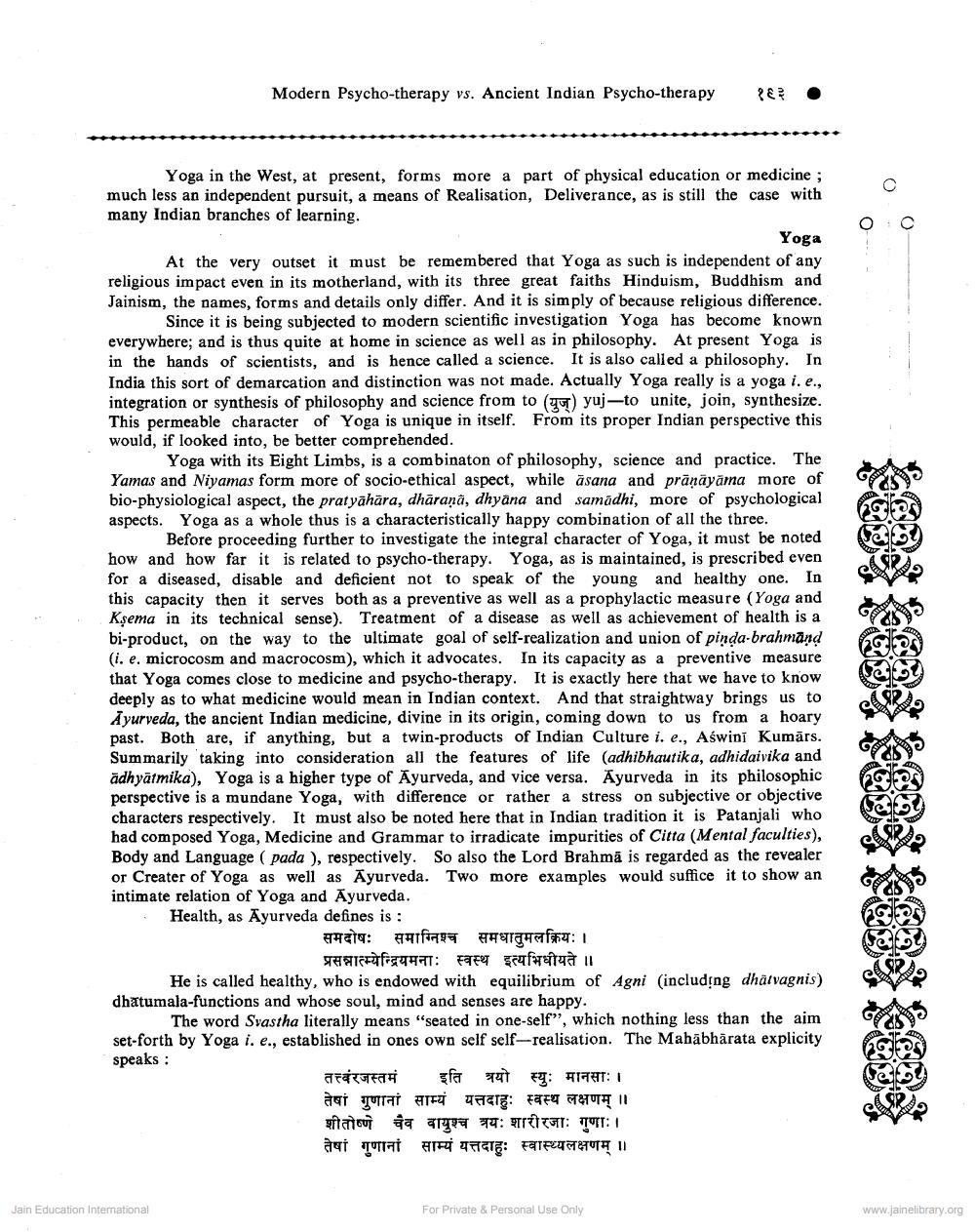________________
Modern Psycho-therapy vs. Ancient Indian Psycho-therapy १६३
Yoga in the West, at present, forms more a part of physical education or medicine; much less an independent pursuit, a means of Realisation, Deliverance, as is still the case with many Indian branches of learning.
Yoga
At the very outset it must be remembered that Yoga as such is independent of any religious impact even in its motherland, with its three great faiths Hinduism, Buddhism and Jainism, the names, forms and details only differ. And it is simply of because religious difference. Since it is being subjected to modern scientific investigation Yoga has become known everywhere; and is thus quite at home in science as well as in philosophy. At present Yoga is in the hands of scientists, and is hence called a science. It is also called a philosophy. In India this sort of demarcation and distinction was not made. Actually Yoga really is a yoga i. e., integration or synthesis of philosophy and science from to (g) yuj-to unite, join, synthesize. This permeable character of Yoga is unique in itself. From its proper Indian perspective this would, if looked into, be better comprehended.
Yoga with its Eight Limbs, is a combinaton of philosophy, science and practice. The Yamas and Niyamas form more of socio-ethical aspect, while asana and prāṇāyāma more of bio-physiological aspect, the pratyahara, dhāraṇā, dhyana and samadhi, more of psychological aspects. Yoga as a whole thus is a characteristically happy combination of all the three.
Before proceeding further to investigate the integral character of Yoga, it must be noted how and how far it is related to psycho-therapy. Yoga, as is maintained, is prescribed even for a diseased, disable and deficient not to speak of the young and healthy one. In this capacity then it serves both as a preventive as well as a prophylactic measure (Yoga and Kşema in its technical sense). Treatment of a disease as well as achievement of health is a bi-product, on the way to the ultimate goal of self-realization and union of pinda-brahmaṇḍ (i. e. microcosm and macrocosm), which it advocates. In its capacity as a preventive measure that Yoga comes close to medicine and psycho-therapy. It is exactly here that we have to know deeply as to what medicine would mean in Indian context. And that straightway brings us to Ayurveda, the ancient Indian medicine, divine in its origin, coming down to us from a hoary past. Both are, if anything, but a twin-products of Indian Culture i. e., Aświni Kumārs. Summarily taking into consideration all the features of life (adhibhautika, adhidaivika and adhyatmika), Yoga is a higher type of Ayurveda, and vice versa. Ayurveda in its philosophic perspective is a mundane Yoga, with difference or rather a stress on subjective or objective characters respectively. It must also be noted here that in Indian tradition it is Patanjali who had composed Yoga, Medicine and Grammar to irradicate impurities of Citta (Mental faculties), Body and Language ( pada ), respectively. So also the Lord Brahma is regarded as the revealer or Creater of Yoga as well as Ayurveda. Two more examples would suffice it to show an intimate relation of Yoga and Ayurveda.
Jain Education International
Health, as Ayurveda defines is:
समदोषः समाग्निश्च समधातुमलक्रियः । प्रसन्नात्म्येन्द्रियमनाः स्वस्थ इत्यभिधीयते ॥
He is called healthy, who is endowed with equilibrium of Agni (including dhatvagnis) dhatumala-functions and whose soul, mind and senses are happy.
The word Svastha literally means "seated in one-self", which nothing less than the aim set-forth by Yoga i. e., established in ones own self self-realisation. The Mahabharata explicity speaks :
तत्वरजस्तमं इति त्रयो स्युः मानसाः । तेषां गुणानां साम्यं यत्तदाहुः स्वस्थ लक्षणम् ॥ शीतोष्णे चैव वायुश्च त्रयः शारीरजाः गुणाः । तेषां गुणानां साम्यं यत्तदाहुः स्वास्थ्यलक्षणम् ॥
For Private & Personal Use Only
www.jainelibrary.org




